Optimization in Operations Research 2nd
Full chapter download at: https://testbankbell.com/product/optimizationin-operations-research-2nd-edition-rardinsolutions-manual/
Chapter 2 Solutions
profit), s.t. 5x1 + 5x2 ≤ 300 (legs), 0.6x1+ 1.5x2 ≤ 63 (assembly hours), x1 ≤ 50 (wood tops), x2 ≤ 35 (glass tops), x1 ≥ 0, x2 ≥ 0
optimal
= (17 5, 35)
x = (30, 30) to
2-2 (a) max 11x1+ 17x2 (max total return), s.t. x1 + x2 ≤ 12 ($12 million investment), x1 ≤ 10 (max $10 million domestic), x2 ≤ 7 (max $7 million foreign),
x1 ≥ 5x2 (domestic at least half foreign),
x2 ≥ .5x1 (foreign at least half domestic),
x1 ≥ 0, x2 ≥ 0 (b) x ∗=domestic=$5 million,
2 = foreign=$7 million
x1 ≤ 40 (at most 40 thousand from Squawking Eagle), x2 ≤ 30 (at most 30
1Supplement to the 2nd edition of Optimization in Operations Research, by Ronald L. Rardin, Pearson
Higher Education, Hoboken NJ, c 2017. thousand from Crooked Creek), x1 ≥ 0, x2 ≥ 0 (b) x ∗=Squawking Eagle=40
2As of September 24, 2015 thousand, x ∗=Crooked Creek=10 thousand
1 2
2-5 (a) max 450v + 200c (max total profit), s.t 10v + 7c ≤ 70000 (water at most 70000 units), v + c ≤ 10000 (total acreage 10000), v ≤ 7000 (at most 70% vegetables), c ≤ 7000 (at most 70% cotton), v ≥ 0, c ≥ 0 (b) v
= 7000, c ∗ = 0
2-6. (a) min x1 + x2 (min used stock), s.t. 5x1 + 3x2 ≥ 15 (cut at least 15 long rolls), 2x1 + 5x2 ≥ 10 (cut at least 10 short rolls), x1 ≤ 4 (at most 4 times on pattern 1), x2 ≤ 4 (at most 4 times on pattern 2), x1,x2 ≥ 0 and integer (b) Partial cuts make no physical sense because all unused material is scrap. (c)
(e) Both (2, 2) and (3, 1) are feasible and lie on the best contour of the objective.
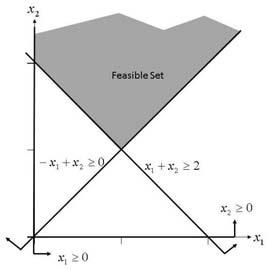
2-7 (a) min 16x1+ 16x2 (min total wall 80 area), s.t. x1x2 = 500 (500 sqft pool), x1 ≥ 2x2 (length at least twice width), 60 x2 ≤ 15 (width at most 15 ft), x1 ≥ 0, x2 ≥ 0
(b) x
=length=33 1 feet, x ∗=width=15 feet
3 2 (c)
x1 ≤ 50 leaves no feasible. 2-9
x1 ≤ 25 leaves no feasible.
2-8. (a) max x2 (max number of floors), s.t π/4(x1)2x2= 150000 (150000 sqft floor space), 10x2 ≤ 4x1 (height at most 4 times diameter), x1 ≥ 0, x2 ≥ 0 (b) x ∗ = diameter
1
(b) min x2 (c) min x1 + x2 (d) max x2 (e)
x2 ≤ 1/2 2-10
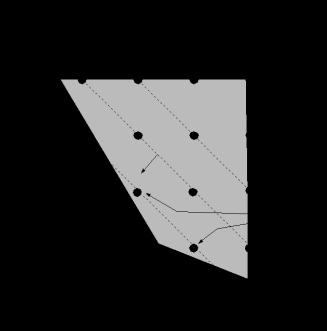
(b) min x1 + x2 (c) min x1 (d) max x1 (e)
x1 + x2 ≤ 1
2-11 (a) min 4 2 j=1 yi,j
(b) max 4
(c) max p (d) min t
2-14. (a)
9 i=1 i=1 i=3 i
j=1 xi,j,t ≤ pi, i = 1,... , 47; t = 1,..., 10; 470 constraints
(b) 0 25 47 9 j=1 xi,j,t ≤ 47 xi,4,t; t =
1,... , 5; 5 constraints
(c) xi,1,t ≥ xi,j,t i = 1,... , 47; j =
1,... , 9; t = 1,... , 10; 4230 constraints
2-15 model; param m; param n; param q; set plots := 1 m; set crops :=
1 .. n; set years := 1 .. q; param p {i in plots }; var x{i in plots, j crops, t in years} >= 0; subject to # part (a) acrelims {i in plots, t in years }:
sum {j in crops } x[i,j,t] <= p[i];
iyi,3 αiyi 4 δiyi
4 j=1 4 j=1 yi,j = si, i = 1,... , 3
aj,iyj = ci, i = 1,... , 3
2-12. (a)
i=1 xi j t ≤ 200, j = 1,..., 5; t = , 7; 35 constraints
5 j=1 (c)
5
7 t=1 x5,j,t ≤ 4000; 1 constraint
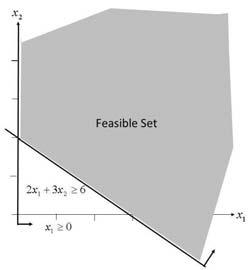
j=1 xi,j,t ≥ 100, i = 1,..., 17; t = 1,... , 7;
119 constraints
2-13 model; param m; param n; param
p; set products:= 1 m; set lines := 1 n; set weeks := 1 p; var
x{i in products, j in lines,t in weeks} >= 0; subject to
# part (a)
linecap {j in lines, t in weeks}: sum {i in products} x[i,j,t] <= 200;
# part (b)
prod5lim: sum {j in lines, t in weeks} x[5,j,t] <= 4000;
# part (c)
minprodn{i in products, t in weeks}: sum {j in lines} x[i,j,t] >= 100;
# data; param m := 17; param n := 5; param p := 7;
# part (b)
crop4min {t in years: t <= 5 }:
0.25* sum {i in plots, j in crops }
x[i,j,t] <= sum {i in plots } x[i,4,t]; # part (c)
beam1st {i in plots, j in crops, t in years}: x[i,1,t] >= x[i,j,t]; #
data; param m := 47; param n := 9; param q := 10;
because LHS is a weighted sum of the decision variables. (b) Linear because both LHS and RHS are weighted sums of the decision variables (c) Nonlinear because LHS has reciprocal 1/x9 (d) Linear because LHS is a weighted sum of the decision variables (e) Nonlinear because LHS has (xj)2 terms. (f) Nonlinear because LHS has log(x1) term, and RHS has a product of
variables (g) Nonlinear because LHS has max operator.(h) Linear because LHS is a weighted sum of the decision variables.
2-18. (a) LP because the objective and all constraints are linear. (b) NLP because of the nonlinear objective function with reciprocal of w2. (c) NLP because of the nonlinear first constraint.(d) LP because the objective and all constraints are linear.
2-19. (a) Continuous because fractions make sense. (b) Discrete because they either closed or not. (c) Discrete because a specific process must be used. (d) Continuous because fractions can probably be ignored.
2-24 (a) Model (d) because LP’s are generally more tractable than ILP’s. (b) Model (d) because LP’s are generally more tractable than NLP’s (c) Model (d) because LP’s are generally more tractable than INLP’s. (d) Model (f) because ILP’s are generally more tractable than INLP’s. (e) Model (g) because LP’s are generatlly more tranctable than ILP’s.
(service NE), y1 + y2 + y3 ≥ 1 (service SE), yj = 0 or 1, j = 1,... , 4 (b) Build 3 and 4, i.e. y ∗ = y ∗ = 0, y ∗ = y ∗ = 1
2-23 (a) ILP because the objective and all constraints are linear, but variables are discrete.(b) NLP because the objective is nonlinear and all variables are continuous (c) INLP because the objective is nonlinear and variables are discrete. (d) LP because the objective and all constraints are linear, and all
the one constraint is nonlinear, and z3 are discrete. (f) ILP because the objective and all constraints are linear, but variables z1 and z3 are discrete (g) LP because the objective and all constraints are linear, and all variables are continuous. (h) INLP because the objective is nonlinear and z3 is discrete.
(a) x2 + x5 + x8 ≤ 2500 (well 2), x3 + x6 + x9 + x10 ≤ 7000 (well 3)
(e) xj ≤ uj, j = 1,... , 10 10
(f)
(g) xj ≥ 0, j = 1,... , 10
(h) A single objective LP because the one objective and all constraints are linear, and all variables are continuous.
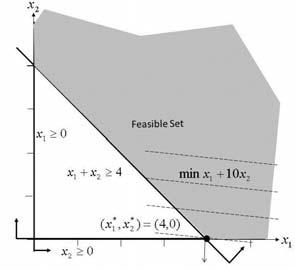
(i)
2-29 (a) The decisions to be made are which projects to undertake.
(b) pj = Δ the profit for project j, mj = Δ the man-days required on project j, and tj = Δ the CPU time required on project j
(c) max 8
(d) 7 ≤ 8 pjxj mj xj /240 ≤ 10 8 j=1
j=1 tj xj ≤ 1000 (computer time), Unique
j=1 xj ≥ 3 (select at least 3); x3 + x4 + x5 + x8 ≥ 1 (include at least 1 of director’s favorites)
(f) xj = 0 or 1, j = 1,... , 8
(g) A single objective ILP because the one objective and all constraints are linear, but variables are discrete. 2-27. (a) min
= x6 = x7 = 1, others = 0
2-30. (a) We must decide what quantities to move from surplus sites to fulfill each need.
(b) si = Δ the supply available at i, rj = Δ the quantity needed at j, di,j = Δ the distance from i to j. 1600 (at most 1600 Ohms resistance), 00175x4 + 00130x5 + 00161x6 + 00095x9 + (c) min 4 7
7
(d) j=1 xi,j = si, i = 1,... , 4 attenuation),
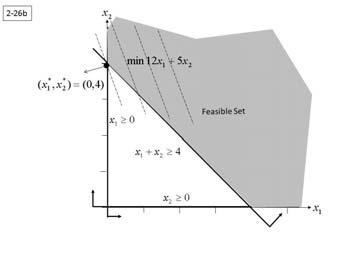
00048x12 ≤ 8 5 (at most 8.5 dBell
(e) 4 i,j j i=1 x = r , j = 1,... , 7 x4,x5,x6,x9,x12 ≥ 0
(b) Nonzeros: x ∗ = 1000, x ∗ = 15000
(f) xi,j ≥ 0, i = 1,... , 4, j = 1,..., 7
(g) A single objective LP because the one 5 12
2-28. (a) Pump rates are the decisions to be made.
(b) uj= Δ the capacity of pump j, cj= Δ the
objective and all constraints are linear, and all variables are continuous.
(h) Nonzeros: x ∗ 1 = 81, x ∗ 2 = 93,
(c) min 10
(d) x1 + x4 + x7 ≤ 3000 (well 1), 2-31
(a) The values to be chosen are the
coefficients in the estimating relationship.
(b) Relatively large values can be rounded if
k/(1 + ea+bfj ) (min fractional without much loss, and continuous total squared error)
(b) min
(c) Single objective NLP because the objective is quadratic, there are no constraints, and all variables are continuous.
2-32 (a) The decisions to be made are where to assign each teacher.
(b)
(min total cost),
is more tractable.
(c) ci,j = Δ the cost of moving a car from i to j, pj = Δ the number of cars presently at j, nj = Δ the number of cars required at j
x
(max (g) A single objective LP because the one total supervisor preference), max objective and all constraints are linear, and
j=1 pi,j xi,j (max total principal all variables are continuous.
4,2 = 115, x4,3 = 165,
22 xi,j = 1, i = 1,... , 22 (each teacher x5,1 = 85, x5,3 = 225
22 xi,j = 1, j = 1,... , 22 (each school
(e) xi,j = 0 or 1, i, j = 1,... , 22
(f) A multiobjective ILP because the 4 objectives and all constraints are linear, but variables are discrete.
2-33 (a) Each task must go to Assistant 0 or Assistant 1
(b) max 100(1 x1) + 80x1 + 85(1 x2) +
70x2 + 40(1 x3) + 90x3 + 45(1 x4) +
85x4+ 70(1 x5) + 80x5+ 82(1 x6) + 65x6
2-36 (a) We must decide how much of what fuel to burn at each plant
min 4 23 p=1 cf,pxf,p
23
(c) min f=1 sf p=1 xf,p
(d) 4 ef xf,p ≥ rp, p = 1,... , 23 (each plant p); 23 constraints
(e) xf,p ≥ 0, f =1,... , 4, p = 1,... , 23; 92 constraints
(f) A multiobjective LP because the 2 objectives and all constraints are linear, and all variables are continuous.
2-37 (a) The available options are to buy 6 j=1 xj = 3 whole logs or green lumber.
(d) x5 = x6
(e) xj = 0 or 1, j = 1,... , 6
(f) A single objective ILP because the one objective and all constraints are linear, but variables are discrete
(g) x ∗ = x ∗ = x ∗ = 1, others = 0 2 3 4
2-34 (a) Batch sizes are the decisions to be made.
(b) min xj /dj , j = 1,... , 4 (each burger j)
(b) Relatively large magnitudes can be rounded without much loss, and continuous is more tractable.
(c) min
70x10 + 200x15+ 620x20+ 1 55y1 + 1 30y2
(d) 100( 09)x10+ 240( 09)x15+ 400( 09)x20+
10y1 + 08y2 ≥ 2350
(e) x10 + x15 + x20 ≤ 1500 (sawing capacity), 100x10+ 240x15+ 400x20+ y1 + y2 ≤ 26500
4 j=1 tj dj /xj ≤ 60 (drying capacity)
(d) 0 ≤ xj ≤ uj, j = 1,... , 4
(e) Multiobjective NLP because the first
constraint is nonlinear and all variables are continuous.
2-35
(a) The issue is how many cars to move from where to where
(f) x10 ≤ 50 (size 10 log availability), x15 ≤ 25 (size 15 log availability), x20 ≤ 10 (size 20 log availability), y1 ≤ 5000 (grade 1 green lumber availability)
(g) x10,x15,x20,y1, y2 ≥ 0
(h) A single objective LP because the one
objective and all constraints are linear, and all variables are continuous.
states := 1 n; var x{i in sites, j in states } >= 0; var y{i in sites }
(i) x ∗ = 50, x ∗ = 25, x ∗ = 5, y ∗ = 5000, binary; param c {i in sites, j in i in sites }
2 = 8500
2-38 (a) Decisions to be made are when to schedule each film.
binary; param r { j in states }; minimize totcost: sum{i in sites, j
(b) min m 1 m aj,j n xj,txj ,t in states} c[i,j]*r[j]*x[i,j] + sum{i
n t=1 m j=1
j=1 j =j+1 t=1
xj,t = 1, j = 1,.. ,m (each film j)
xj,t ≤ 4, t = 1,.. ,n (each time t)
(e) xj,t = 0 or 1, j = 1,.. ,m; t = 1,.. ,n
(f) A single objective INLP because the one objective is nonlinear, and variables are discrete. (g) model; param m; param n; set films := 1 m; set slots := 1 n; var x{j in films,t in slots }
binary; param a{ j in films, jp in films }; minimize totconflict: sum{ j in films, jp in films: j < m and jp >
in sites}f[i]*y[i]; x[j,t]*x[jp,t]; subject to doeach{j in states}: sum{i in sites}x[i,j] = 1; switch {i in
sites, j in states }: x[i,j] <= y[i]; data; param m := 5; param n := 5;
j } a[j,jp]*sum {t in slots} 2-40 (a) max 8 rj xj, subject to, x[j,t]*x[jp,t]; subject to allin {j in films}: sum{ t in slots } x[j,t] = 1; max4 {t in slots}:sum{j in films} x[j,t] <= 4;
2-39 (a) We need to decide both which offices to open and how to service customers from them.
(b) Offices must either be opened or not.
(c) fi = Δ fixed cost of site i, ci,j = Δ unit cost of audits at j from i, rj = Δ required number of audits in state j
j=1 xj ≤ 4, x1 + x2 + x3 ≥ 2, x4 + x5 + x6 + x7 + x8 ≥ 1, x2 + x3 + x4 + x8 ≥ 2, x1 x8 = 0 or 1 (b) model; param n ; set games := 1 n; #ratings param r{j in games}; #home? param h{j in games}; #state? param s{j in games}; #cover? var x{j in games} binary; maximize totrat: sum{j in games} r[j]*x[j]; subjectto capacity: sum{j in games} x[j] <= 4; home: sum{j in games} h[j]*x[j] >= 2;
(d) min 5 5 j=1 ci j rjxi j + 5 fiyi away: sum{j in games}(1-h[j])* x[j] >= 1; state: sum{j in games}s[j]*x[j] 5 i=1
j) xi,j = 1, j = 1,... , 5 (each location >= 2; data; param n := 8; param r :=1
(f) xi,j ≤ yi, i, j = 1,... , 5 (each site i, location j combination)
(g) xi j ≥ 0, i, j = 1,... , 5, yi = 0 or 1, i = 1,... , 5
(h) A single objective ILP because the one objective and all constraints are linear, but the yi variables are discrete.
(i) Nonzeros:
The model is an ILP because all constraints and the objective are linear, but decision variables are binary
2-41 (a) How to divide funds is the issue.
(f) xj ≤ uj , j = 1,... ,n (each category j)
(g) A multiobjective LP because the 2 objectives and all constraints are linear, and all variables are continuous.
2-42. (a) The issue is which module goes to which site.
(b) If xi,j xi ,j = 1 the i is at j and i is at j , so wire dj,j will be required. Summing over all possible location pairs captures the wire requirements for i and i
(c) min
m 1 m n n i=1
j
(d) n i =i+1 ai,i =1 j =1 dj,j xi,j xi ,j xi,j = 1, i = 1,.. ,m (each module j=1 i)
(e)
m i=1 xi,j ≤ 1, j = 1,.. ,n (each site j)
(f) xi,j = 0 or 1, i = 1,.. ,m, j = 1,.. ,n
(g) Single objective INLP because the one objective is nonlinear and variables are discrete. (h) model; param m; param n; set modules := 1 .. m; set sites := 1 n; var x{i in modules, j in sites
} binary; param a{ i in modules, ip in modules }; param d{ j in sites, jp in sites }; minimize totdist: sum{ i in modules, ip in modules: i < m and ip > i } a[i,ip] sum{j in sites, jp in sites: j < n and jp > j }
d[j,jp]*x[i,j]*x[ip,jp]; subject to alli {i in modules
: sum
